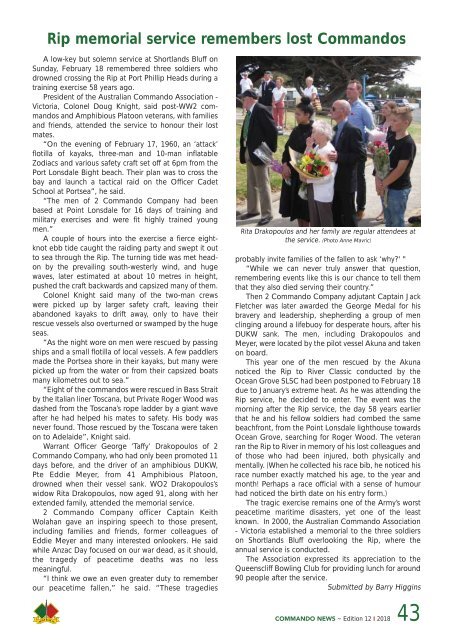Commando News Issue 12 2018
You also want an ePaper? Increase the reach of your titles
YUMPU automatically turns print PDFs into web optimized ePapers that Google loves.
Rip memorial service remembers lost <strong>Commando</strong>s<br />
A low-key but solemn service at Shortlands Bluff on<br />
Sunday, February 18 remembered three soldiers who<br />
drowned crossing the Rip at Port Phillip Heads during a<br />
training exercise 58 years ago.<br />
President of the Australian <strong>Commando</strong> Association -<br />
Victoria, Colonel Doug Knight, said post-WW2 com -<br />
mandos and Amphibious Platoon veterans, with families<br />
and friends, attended the service to honour their lost<br />
mates.<br />
“On the evening of February 17, 1960, an ‘attack’<br />
flotilla of kayaks, three-man and 10-man inflatable<br />
Zodiacs and various safety craft set off at 6pm from the<br />
Port Lonsdale Bight beach. Their plan was to cross the<br />
bay and launch a tactical raid on the Officer Cadet<br />
School at Portsea”, he said.<br />
“The men of 2 <strong>Commando</strong> Company had been<br />
based at Point Lonsdale for 16 days of training and<br />
military exercises and were fit highly trained young<br />
men.”<br />
A couple of hours into the exercise a fierce eightknot<br />
ebb tide caught the raiding party and swept it out<br />
to sea through the Rip. The turning tide was met headon<br />
by the prevailing south-westerly wind, and huge<br />
waves, later estimated at about 10 metres in height,<br />
pushed the craft backwards and capsized many of them.<br />
Colonel Knight said many of the two-man crews<br />
were picked up by larger safety craft, leaving their<br />
abandoned kayaks to drift away, only to have their<br />
rescue vessels also overturned or swamped by the huge<br />
seas.<br />
“As the night wore on men were rescued by passing<br />
ships and a small flotilla of local vessels. A few paddlers<br />
made the Portsea shore in their kayaks, but many were<br />
picked up from the water or from their capsized boats<br />
many kilometres out to sea.”<br />
“Eight of the commandos were rescued in Bass Strait<br />
by the Italian liner Toscana, but Private Roger Wood was<br />
dashed from the Toscana’s rope ladder by a giant wave<br />
after he had helped his mates to safety. His body was<br />
never found. Those rescued by the Toscana were taken<br />
on to Adelaide”, Knight said.<br />
Warrant Officer George ‘Taffy’ Drakopoulos of 2<br />
<strong>Commando</strong> Company, who had only been promoted 11<br />
days before, and the driver of an amphibious DUKW,<br />
Pte Eddie Meyer, from 41 Amphibious Platoon,<br />
drowned when their vessel sank. WO2 Drakopoulos’s<br />
widow Rita Drakopoulos, now aged 91, along with her<br />
extended family, attended the memorial service.<br />
2 <strong>Commando</strong> Company officer Captain Keith<br />
Wolahan gave an inspiring speech to those present,<br />
including families and friends, former colleagues of<br />
Eddie Meyer and many interested onlookers. He said<br />
while Anzac Day focused on our war dead, as it should,<br />
the tragedy of peacetime deaths was no less<br />
meaningful.<br />
“I think we owe an even greater duty to remember<br />
our peacetime fallen,” he said. “These tragedies<br />
Rita Drakopoulos and her family are regular attendees at<br />
the service. (Photo Anne Mavric)<br />
probably invite families of the fallen to ask ‘why?' "<br />
“While we can never truly answer that question,<br />
remembering events like this is our chance to tell them<br />
that they also died serving their country.”<br />
Then 2 <strong>Commando</strong> Company adjutant Captain Jack<br />
Fletcher was later awarded the George Medal for his<br />
bravery and leadership, shepherding a group of men<br />
clinging around a lifebuoy for desperate hours, after his<br />
DUKW sank. The men, including Drakopoulos and<br />
Meyer, were located by the pilot vessel Akuna and taken<br />
on board.<br />
This year one of the men rescued by the Akuna<br />
noticed the Rip to River Classic conducted by the<br />
Ocean Grove SLSC had been postponed to February 18<br />
due to January’s extreme heat. As he was attending the<br />
Rip service, he decided to enter. The event was the<br />
morning after the Rip service, the day 58 years earlier<br />
that he and his fellow soldiers had combed the same<br />
beachfront, from the Point Lonsdale lighthouse towards<br />
Ocean Grove, searching for Roger Wood. The veteran<br />
ran the Rip to River in memory of his lost colleagues and<br />
of those who had been injured, both physically and<br />
mentally. (When he collected his race bib, he noticed his<br />
race number exactly matched his age, to the year and<br />
month! Perhaps a race official with a sense of humour<br />
had noticed the birth date on his entry form.)<br />
The tragic exercise remains one of the Army’s worst<br />
peacetime maritime disasters, yet one of the least<br />
known. In 2000, the Australian <strong>Commando</strong> Association<br />
- Victoria established a memorial to the three soldiers<br />
on Shortlands Bluff overlooking the Rip, where the<br />
annual service is conducted.<br />
The Association expressed its appreciation to the<br />
Queenscliff Bowling Club for providing lunch for around<br />
90 people after the service.<br />
Submitted by Barry Higgins<br />
COMMANDO NEWS ~ Edition <strong>12</strong> I <strong>2018</strong> 43

















